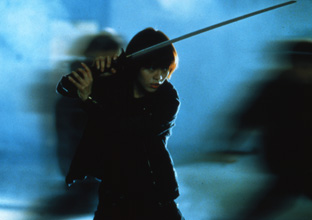Shurayuki hime
The Princess Blade
Sato Shinsuke
Japan 2001 |
| |
|
 |
|
|
Delphi
09.02., 24.00
CineStar 8
10.02., 21.30
CineStar 8
11.02., 14.00
|
|
|
|
|
Produktion: Oz Production
Weltvertrieb: Kadokawa Shoten Publishing
2-13-3 Fujimi Chiyoda-ku Tokyo, 102-8177
Tel.: (81-3) 3238 8485, Fax: 3238 8612
e-mail: entertainment@kadokawa.ca.jp
Buch: Sato Shinsuke
Kamera: Kawazu Taro
Musik: Kawai Kenji
Special Effects: Higuchi Shinjii
Regie Kampfszenen: Donnie Yen
Schnitt: Abe Hirohide.
Darsteller: Ito Hideaki, Shaku Yumiko, Sano
Shiro, Numata Yoichi, Shimada Kyusaku
Format: 35mm, 1:1.85, Farbe
Länge: 92 Minuten, 24 Bilder/Sek.
Sprache: japanisch |
|
|
|
| sRegierung eines Landes, das 500 Jahre lang von der übrigen
Welt abgeschieden war, versucht eine terroristische Rebellen-organisation
mit Hilfe der Takemikazuchi zu kontrollieren, der ehemaligen kaiserlichen
Wachmannschaften. Diese sind aus ihrem Land geflohen, als ihr Monarch abgesetzt
wurde, und haben sich zu einer vagabundierenden Bande von Auftragskillern
entwickelt. Yuki, eine von ihnen, ist fast zwanzig. Sie soll ein anderes
Mitglied der Takemikazuchi töten. Unterwegs trifft sie einen geheimnisvollen
älteren Mann namens Kuka, der behauptet, der Diener ihrer verstorbenen
Mutter, der Prinzessin Azora, gewesen zu sein. Kuka erzählt, dass Byakurai,
der jetzige Anführer der Takemikazuchi, Azora töten ließ.
Daraufhin stellt Yuki Byakurai zur Rede. Er bedroht sie jedoch, und sie
muss fliehen. Dabei trifft sie auf Takashi, ein Mitglied der Terrororganisation.
Der fühlt sich schuldig am Tod einiger Menschen, die durch ei-ne Bombe
von ihm ums Leben kamen... Sato hat die größten asiatischen Talente
um sich geschart, wie z.B. Higuchi Shinji, der mit seinen Spezialeffekten
bereits die japanische Serie Gamera wieder aufleben ließ. Die Kampfszenen
wurden von dem erfolgreichen Hongkong-Schauspieler und Martial-Arts-Regisseur
Donnie Yen choreographiert. Der Komponist Kawai Kenji schrieb u.a. die Musik
für Ghost in the Shell (Forum 1996). Sie alle garantieren für
ein opulentes Kinostück. |
| |
|
| In a nation closed to the outside for 500 years, the government
seeks to repress a terrorist rebel organization by means of the Takemikazuchi,
former imperial guards to the ruler of a neighbouring nation who fled to
this one when their monarch was deposed, and who are now a roving band of
hired assassins. Yuki, one of the Takemi-kazuchi, is about to turn 20. Sent
out to kill a companion attempting to flee the group, she encounters a mysterious
older man, Kuka, who tells her that he was the servant of her late mother,
the Princess Azora, and that Azora’s death came at the hands of Byakurai,
now the Takemikazuchi leader. Yuki confronts Byakurai and is forced to flee.
Staggering through the forest to a road, she climbs into the back of a passing
truck driven by Takashi, a member of the terrorist organisation who wants
to leave it out of guilt at having killed a number of people with a bomb
he planted in the National Assembly... Sato surrounded himself with top
talent from Asia, including Higuchi Shinji, the man behind the special effects
that lead to the rebirth of the Gamera series. Combat and fighting sequences
were choreographed by top Hong Kong actor and mar-tial arts director Donnie
Yen. The composer Kawai Kenji did the music scores for films such as Oshii
Mamoru’s Ghost in the Shell (Forum 1996). The meeting of two genres,
high tech action and Asian swordplay, is what The Princess Blade is all
about. |
| |
|
Biographien / Biographies
Sato Shinsuke, geb. 1970, aufgewachsen in der Präfektur Hiroshima.
Graphikstudium. Filme als Autor und Regisseur seit 1993, u.a. Tsukishima
Capriccio (1994), Bound for the Front Gate (1996), Tokyo Lullaby (Regie:
Ichikawa Jun, Forum 1998). Shurayuki hime ist sein erster Versuch im Action-Genre.
|
